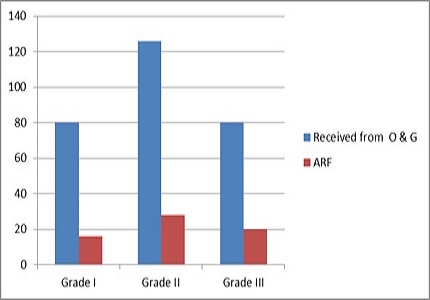Study of renal function test in asphyxiated newborns and their outcome
Abstract
Introduction: There is a high incidence of acute kidney injury (AKI) among asphyxiated term. AKI manifests by changes in urine output and blood chemistries & can have serious clinical consequences. Oliguria has been reported in higher number of neonates affecting nearly 25%- 70% babies.
Methodology: This study was undertaken to study renal failure in asphyxiated neonates. This is a prospective case controlled study done over a period of two years. Various clinical, biochemical and radiographic parameters pertaining to renal injury among asphyxiated neonates were studied.
Results: About 64 asphyxiated newborns were studied. Majority (53.12%) was term weighing between 2.5-3 kg & most of them were in HIE-2 grade (43.75%). Oliguria was mostly noted among HIE - 3 (31.57%). Birth asphyxia and subsequent acute renal failure was more in babies delivered vaginally. Biochemical parameters also showed correlation with the severity of asphyxia. Premature babies were more prone to develop renal failure secondary to asphyxia. Mortality was directly related to severity of perinatal asphyxia and presence of oliguria.
Conclusion: The incidence of acute renal failure due to perinatal asphyxia was high. Incidence with oliguria was high in severe asphyxia. Prevention of asphyxia & prompt management of morbidities like ARF can improve the outcome of perinatal asphyxia.
Downloads
References
Gupta BD, Sharma P, Bagla J, Parakh M, Soni JP. Renal failure in asphyxiated neonates.Indian Pediatr. 2005 Sep;42(9):928-34.
Karlowicz MG1, Adelman RD. Nonoliguric and oliguric acute renal failure in asphyxiated term neonates.PediatrNephrol. 1995 Dec;9(6):718-22.
Martin-Ancel Ana, Garcia Alix Alfredo, Gaya Francisco, Cabanas Fernando, Buergeros Margarita. Multiple organ involvement in perinatal asphyxia.J Pediatr. 1995;127:786-93.
Carter B, McNabb F. Prospective validation of a scoring system for predicting neonatal morbidity after acute perinatal asphyxia. J Pediatr.1998; 132: 619-23.
Perlman J, Tack E, Martin T, et al. Acute systemic organ injury in term infants after asphyxia. Am J Dis Child. 1989;143(5):617-620. doi: https://doi.org/10.1001/archpedi.1989.02150170119037.
Chertow GM1, Burdick E, Honour M, Bonventre JV, Bates DW.Acute kidney injury, mortality, length of stay, and costs in hospitalized patients.J Am SocNephrol. 2005 Nov;16(11):3365-70. Epub 2005 Sep 21.
Perlman &, Tackle. Renal injury in the asphyxiated newborn infant: Relationship to neurogenic outcome. J Pediatr 1998; 113: 875-879.
Task Force American College of Obstetricians and Gynecologists and The American Academy of Pediatrics. Neonatal encephalopathy and CP. Defining the pathogenesis and pathophysiology. Washington DC: ACOG, 2003.
Lilly Dubowitz,Daniela Ricci,EugenioMercuri; the dubowitz neurological examination Of the full term newborn; mental retardation and developmental disabilities research reviews 11: 52–60 (2005).
Giovanni Ottonello, Angelica Dessì, Paola Neroni, Maria ElisabettaTrudu, Danila Manus, VassiliosFanos. Acute kidney injury in neonatal age; Journal of Pediatric and Neonatal Individualized Medicine 2014;3(2):e030246; doi: https://doi.org/10.7363/030246.
Sarnat H, Sarnat M. Neonatal encaphalopathy following fetal distress. Arch Neurol. 33:695 - 705. 1976.
Airede A, Bello M, Weerasinghe HD. Acute renal failure in the newborn: Incidence and outcome. J Paediatr Child Health. 1997;33:246–9.
Mortazavi F, HosseinpourSakha S, Nejati N. Acute kidney failure in neonatal period. Iran J Kidney Dis. 2009;3:136–40.
Alejandro G. jenik, Josc M. CerianiCernadas, AdriancGorenstin, dose A. Ramizer, Nester Vain, Marcelo Armadons and Forge R. Ferrairs. A randomized, double blind, placebo controlled trial of the effect of prophylactic theophyline on renal function in term neonates with perinatal asphyxia. Pediatrics 2000; 105;4:P.45.
Pamrhi V. Mohan, Pragnya M. Pai (2000). Renal insult in Asphyxia neonatorum. Indian journal of Paediatrics 2000;37: 1102-1106.
Finer NN, Robertson CM, Richards RT, Pinnell LE, Peters KL. Hypoxic-ischemic encephalopathy in term neonates: perinatal factors and outcome.J Pediatr. 1981 Jan;98(1):112-7.
Chandra S1, Ramji S, Thirupuram S. Perinatal asphyxia: multivariate analysis of risk factors in hospital births.Indian Pediatr. 1997 Mar;34(3):206-12.
Norman M; Assadi FK (1979). A prospective study of acute renal failure in the newborn infant. Pediatrics 63:475-480.
Willis F, Summers J, Minutillo C, Hritt I., Indices of renal tubular function in perinatal asphyxia. Arch Dis. Child (Fetal neonatal Ed.) 1997;77:F57-F60.
Chevalier RL, Campbell F, Brenbridge ANAG (1984). Prognostic factors in neonatal acute renal failure.Paediatrics 74:265-272.
Roberts DS, Haycoch GB, Dalton RN, Tusncer C, Tomliman P, Stimmler L, Scopes JW. Prediction of acute renal failure after birth asphyxia. Arch. Dis. Child 1990;65:1021-1028.
Bailie MD. Renal function and disease.ClinPerinatol 1992;19:91-92.
Shaffer SE, Norman ME, Renal function and renal failure in the newborn, ClinPerinatol 1989;16:199-218.
Tack ED1, Perlman JM, Robson AM.Renal injury in sick newborn infants: a prospective evaluation using urinary beta 2-microglobulin concentrations.Pediatrics. 1988 Mar;81(3):432-40.
Mathew OP et al. Neonatal renal failure: Usefulness of diagnostic indices. Pediatr 1980;65-57.



 OAI - Open Archives Initiative
OAI - Open Archives Initiative


